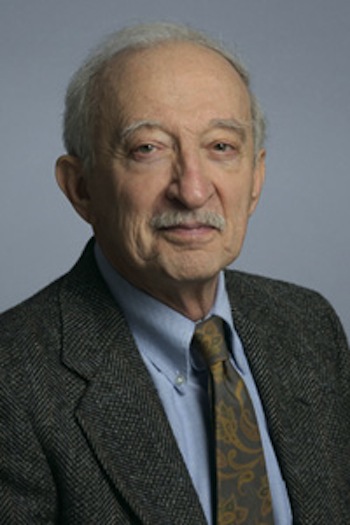Arts Fuse Remembrance: David Aronson, Boston Expressionist
By Peter Walsh

The late David Aronson — while American art grew bolder, larger, louder, and more ironic, he was mystical, introspective, and poetic. Photo: Boston University.
There was a time, in the 1940s and 50s, when it looked as though Boston might shed its provincial and deeply conservative attitude towards the visual arts and become a leading center of contemporary American art. The reason was the “Boston Expressionist School,” a loosely organized group of angry, energetic figurative painters who lived and worked in the grimy and rather threadbare Hub of that era. Many “school” members were Jewish, born in the Russian Empire, and raised in the Boston slums. Some trained at Harvard University or the School of the Museum of Fine Arts, though they lacked the Brahmin tastes and connections that ruled these places, and most were influenced by the German Expressionists, some of whose work, banned by the Nazis, had found its way to Harvard’s Busch-Reisinger Museum.
The painter and sculptor David Aronson, one of the last living members of the “second generation” of Boston Expressionists and one of the most successful of all, died on July 2 at the age of 91. Unlike so many Boston-bred or -educated visual artists, though, Aronson never left his native city for more hospitable locations elsewhere. Instead, in 1955, after establishing a reputation as a leading American artist of his generation with exhibitions in Boston and New York’s Museum of Modern Art, Aronson took a teaching post at Boston University. He stayed on for the rest of his long career, founding the university’s School of Fine Arts and teaching there until his retirement in 1989.
Aronson’s tightly faceted images, which mixed influences of Rembrandt and Cubism with Eastern European modernism, often explored Biblical themes and complex moral issues. This religious bent, as well as Aronson’s figurative approach, put him at odds with the secular, abstract, or deadpan imagery that became the American mainstream. While American art grew bolder, larger, louder, and more ironic, he was mystical, introspective, and poetic. He was famous for taking on ancient techniques like encaustic and charcoal.
Ensconced in a visual arts backwater, Aronson was nevertheless widely exhibited and collected throughout his career. He received numerous awards, among them a Guggenheim Fellowship, and is now represented in the permanent collections of dozens of art museums, including almost all of the leading modern art collections in the United States. In the twenty-first century, Boston-area exhibitions at Boston University and the Danforth Museum looked back on a rich and productive artistic career that never strayed far from home.
Peter Walsh has worked for the Harvard Art Museums, the Museum of Fine Arts, Boston, Wellesley College, The Metropolitan Museum of Art, Dartmouth College, and the Boston Athenaeum, among other institutions. His reviews and articles on the visual arts have appeared in numerous publications and he has lectured widely in the United States and Europe. He has an international reputation as a scholar of museum studies and the history and theory of media.

Thanks for this excellent summary. I was pleasantly surprised that the article has no trace of the usual prejudice lavished on Aronson’s religious and humanist approach. Perhaps the tide of fashion will one day again favor this poignant, poetic work. Philip Guston experienced the same prejudice when he departed from formalist gestural abstraction to return to humanist subject matter and the human tragicomic story. That’s why Guston felt comfortable at BU where Aronson had established a haven for young artists who didn’t want the tendentious claptrap of the marketplace to rule their studio practice. These two and several others of the Boston Expressionist group contributed greatly to the formation of generations of painters and sculptors of distinction.